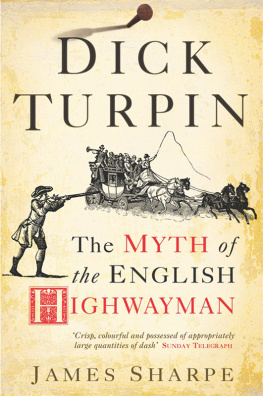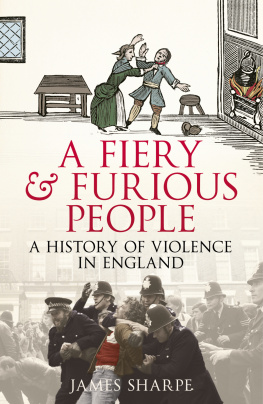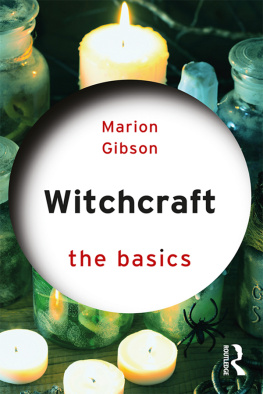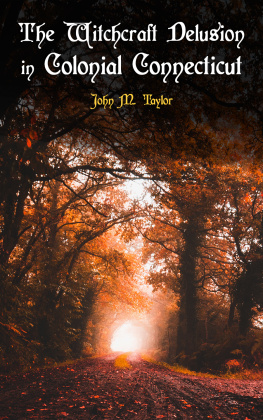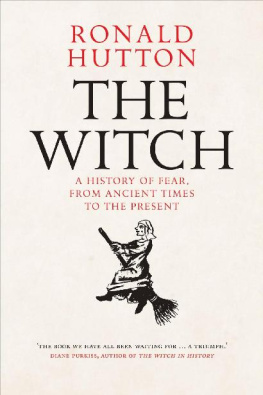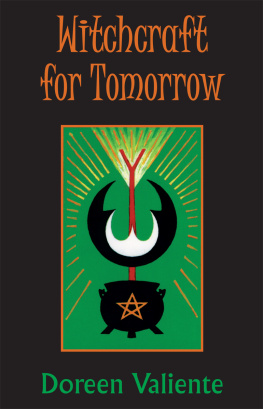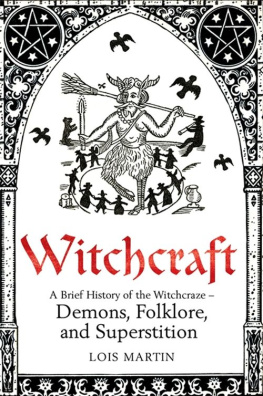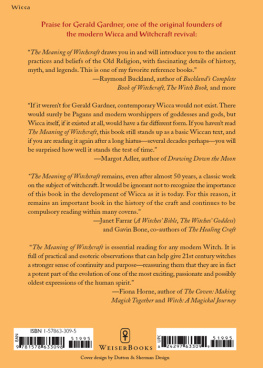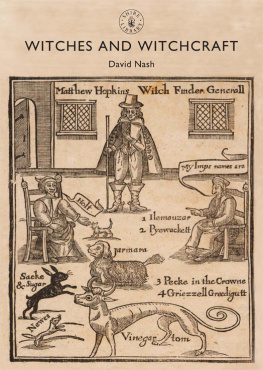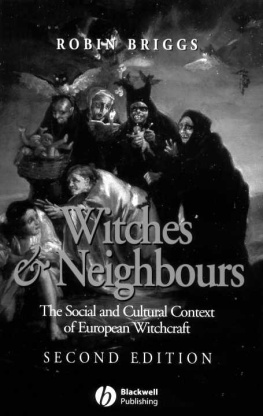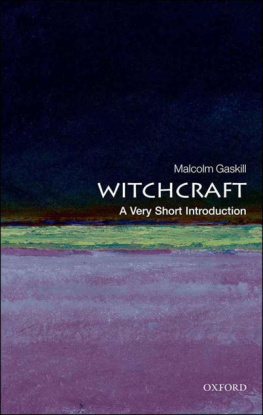Witchcraft in Early Modern England
Witchcraft in Early Modern England provides a fascinating introduction to the history of witches and witchcraft in England from the sixteenth to the eighteenth century.
Witchcraft was a crime punishable by death in England during this period and this book charts the witch panics and legal persecution of witches that followed, exploring topics such as elite attitudes to witchcraft in England, the role of pressures and tensions within the community in accusations of witchcraft, the way in which the legal system dealt with witchcraft cases, and the complex decline of belief in witchcraft. Revised and updated, this new edition explores the modern historiographical debate surrounding this subject and incorporates recent findings and interpretations of historians in the field, bringing it right up-to-date and in particular offering an extended treatment of the difficult issues surrounding gender and witchcraft.
Supported by a range of compelling primary documents, this book is essential reading for all students of the history of witchcraft.
James Sharpe is Professor Emeritus in early modern history at the University of York. He has published extensively on the social history of England between 1550 and 1750, specialising in the history of crime and in the history of witchcraft.
Introduction to the series
History is the narrative constructed by historians from traces left by the past. Historical enquiry is often driven by contemporary issues and, in consequence, historical narratives are constantly reconsidered, reconstructed and reshaped. The fact that different historians have different perspectives on issues means that there is often controversy and no universally agreed version of past events. Seminar Studies was designed to bridge the gap between current research and debate, and the broad, popular general surveys that often date rapidly.
The volumes in the series are written by historians who are not only familiar with the latest research and current debates concerning their topic, but who have themselves contributed to our understanding of the subject. The books are intended to provide the reader with a clear introduction to a major topic in history. They provide both a narrative of events and a critical analysis of contemporary interpretations. They include the kinds of tools generally omitted from specialist monographs: a chronology of events, a glossary of terms and brief biographies of whos who. They also include bibliographical essays in order to guide students to the literature on various aspects of the subject. Students and teachers alike will find that the selection of documents will stimulate the discussion and offer insight into the raw materials used by historians in their attempt to understand the past.
Clive Emsley and Gordon Martel
Series Editors
Second edition published 2020
by Routledge
2 Park Square, Milton Park, Abingdon, Oxon, OX14 4RN
and by Routledge
52 Vanderbilt Avenue, New York, NY 10017
Routledge is an imprint of the Taylor & Francis Group, an informa business
2020 James Sharpe
The right of James Sharpe to be identified as author of this work has been asserted by him in accordance with sections 77 and 78 of the Copyright, Designs and Patents Act 1988.
All rights reserved. No part of this book may be reprinted or reproduced or utilised in any form or by any electronic, mechanical, or other means, now known or hereafter invented, including photocopying and recording, or in any information storage or retrieval system, without permission in writing from the publishers.
Trademark notice: Product or corporate names may be trademarks or registered trademarks, and are used only for identification and explanation without intent to infringe.
British Library Cataloguing-in-Publication Data
A catalogue record for this book is available from the British Library
Library of Congress Cataloging-in-Publication Data
Names: Sharpe, J. A., author.
Title: Witchcraft in early modern England / James Sharpe.
Description: Second Edition. | New York : Taylor & Francis, 2019. | Includes bibliographical references and index. |
Identifiers: LCCN 2019012725 (print) | LCCN 2019017601 (ebook) | ISBN 9780429300318 (eBook) | ISBN 9781138831162 (pbk. : alk. paper) | ISBN 9781138831155 (hardback : alk. paper)
Subjects: LCSH: Witchcraft--England--History.
Classification: LCC BF1581 (ebook) | LCC BF1581 .S53 2019 (print) | DDC 133.4/30942--dc23
LC record available at https://lccn.loc.gov/2019012725
ISBN: 978-1-138-83115-5 (hbk)
ISBN: 978-1-138-83116-2 (pbk)
ISBN: 978-0-429-30031-8 (ebk)
For Pyewackett
Too Dim to be Demonic
It seems that every month brings with it a new book on the history of witchcraft: a work of synthesis, a regional study, a book exploring a new interpretation of the phenomenon, a newly edited version of a demonological text. The subject is one of ever-growing complexity, one where professional historians, working on sometimes intractable court records or on difficult and massive printed works, are constantly challenging the assumptions about witchcraft held by both non-specialist historians and the general public. Most of this research centres on the period of witch persecution in the late middle ages and the early modern period, let us say between about 1450 and 1750. Much of this work is concerned with continental Europe (scholarly work on German witchcraft in particular has experienced something of a renaissance recently), while the flow of publications on the trials at Salem in 1692 seems unending. The aim of this book, appearing as it does at such an exciting point in witchcraft studies, is to provide the reader with a short introduction to the history of witchcraft in early modern England, focusing especially on the period when witchcraft was a secular crime, conviction for which might lead to execution, that is between 1542 (or, perhaps more meaningfully, 1563) and 1736. Experience as a university teacher has convinced me of the need for such a book.
Because of this, I am envisaging that the main readership for this book will be undergraduates, although the tendency for witchcraft to be taught in sixth-form history courses, and to provide the basis for Advanced Level project work, has made me aware of a readership in schools. It seems likely that most of the students reading this book would be taking history, although it may well also be of use to students of English literature, and would also help provide an historical context to students studying witchcraft in a number of other disciplines, notably womens studies and anthropology. I would also hope that this book will be of use and interest to anybody requiring a guide to the history of witchcraft, especially of witchcraft in England.
The geographical and chronological structure of the book has already been made clear. The thematic structure is dictated by an attempt to examine some of what the general consensus among historians would consider to be the main approaches to the subject. After a brief introduction in which some general themes are raised, the first chapter is focused upon how witchcraft looked to people who were in positions of authority (whether that authority was political, administrative, theological or cultural), thus illuminating what sort of ways of thinking about witchcraft might be open to the educated inhabitant of early modern England. The second chapter looks at what has been one of the major themes of English witchcraft studies since the early 1970s, the connection between local community pressures, neighbourly tensions, and witchcraft accusations and trials. Some of the issues raised in this chapter are carried on to the next, which consists of an exploration of some of the broader aspects of witchcraft as an element in popular culture. The fourth chapter addresses what is still one of the most problematic aspects of the history of witchcraft in England, and, indeed, in Europe more generally, namely that of the decline of belief in witchcraft, or, to be more accurate, that of a decline of witchcraft beliefs among the educated elite. There then comes an assessment where a number of threads are pulled together and reassessed, a selection of documentary extracts chosen to illustrate and support the arguments and interpretations put forward in the text of the book, and an up-to-date bibliography.


